Good video stories need strong individual shots. Great video stories present those shots in a sequence that complements the parts and creates a much greater whole.
Shooting and editing effective sequences are essential video storytelling skills. Shot sequences can enhance cohesion, help communicate more information in less time and create an overall sense of purpose.
In video storytelling, a sequence is simply a series of shots that works together to show an action unfolding. Shot sequences are ubiquitous — most shots in most stories are part of a larger sequence. That’s because they’re a foundational storytelling tool in a medium that’s not only visual but also depicts the passage of time.
Benefits of shot sequences
Shot sequences offer three main benefits:
Shot sequences promote continuity. When audiences see a disparate collection of images that don’t seem to fit together, they often experience a sense of disorientation. They’re pushed away from, rather than pulled in to, the story. Sequences are the remedy. A good shot sequence creates a seamless progression. Everything seems to build as the sequence unfolds. When it ends, you’re ready for the next sequence to begin. This clarifies what you’re watching. And it creates an impression that something continuous is unfolding before you. Sequencing is so important that it’s the bedrock of an entire school of filmography — continuity editing — that influences not only video stories but just about every Hollywood movie released in the past 100 years.
Shot sequences compress time. A good shot sequence conveys the full meaning of an action or event without requiring real-time observation. That means you can express more ideas in less time, with fewer extraneous details.
Shot sequences add professional polish. A few simple steps can make amateur video footage a little more professional. You can take steadier shots (possibly by employing a tripod). You can minimize zooms, pans and other camera movements. And, perhaps most of all, you can shoot in sequences. A good shot sequence conveys purpose and direction. This sense of intention immediately bolsters the professionalism of a piece.
Key ingredients in sequences
Shooting sequences start with identifying specific actions — discrete events that unfold visually and can be captured by a camera. The key to spotting actions is to get specific. Rather than “cooking dinner,” think “dicing a potato.” Rather than “delivering mail,” think “putting a particular letter in a particular mailbox.”
The most challenging part of identifying actions is figuring out what’s going to happen in advance so you’re ready to record when the moment comes. Video storyteller Colin Mulvany calls this “anticipating the action.” This is a skill that can seem intuitive, but it often emerges from thoughtful planning upfront.
Variety is another key consideration. Good sequences result from a diverse mix of angles, distances from the subject and compositions (how subjects are positioned in a shot). It’s especially important to use variety in back-to-back shots.
Together, specificity, anticipation and variety lead to strong sequences.
Sequence patterns
No two shot sequences are exactly the same. But most sequences can be grouped into just a few different formats. Journalism educator Andrew Lih calls these patterns.
The great thing about a pattern is its flexibility. You learn a pattern once, then focus on all the different ways you can employ it.
Several sequencing patterns have become popular in video storytelling:
The two-shot sequence. Even two shots can create a sequence when they capture the same subject from different angles. Imagine a wide shot — one taken at some distance — of a person sitting on a park bench, followed by a much closer shot that reveals details of the person’s face and shows she’s reading a magazine. Or, you could start with a close-up of a subject’s face and proceed to a close-up of his hands. Two-shot sequences are simply back-to-back shots of the same thing from different angles and/or distances.
The three-shot sequence. Three-shot sequences usually employ a combination of wide (long), medium and close-up shots to depict the same subject from three distances. Often, different angles are used for each shot. A good three-shot sequence to practice is to start wide (at the greatest distance) and move progressively closer to the subject.
The following three-shot sequence from a Time video on extreme couponers shows this popular technique in action.
-

- The first shot in this sequence is the widest. It establishes the place and highlights the subject. (Jacob Templin/Time)
-
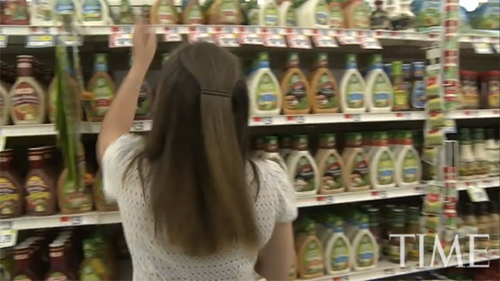
- The second shot in the sequence shows the subject reaching for a bottle of salad dressing. The camera has moved closer, and the angle has changed. (Jacob Templin/Time)
-

- The third (and final) shot in the sequence is the closest. The camera has moved in on the shelf, where the subject is about to take a bottle, and the angle has again shifted. (Jacob Templin/Time)
The five-shot sequence. This sequence, popularized by video journalist Michael Rosenblum, also relies on wide, medium and close-up shots, while introducing the idea of perspective. In a five-shot sequence, the first shot is a close-up of a subject’s hands — a pianist, for example, tickling the ivories. The next shot is a close-up of the subject’s face. For the third shot, move back from the action and capture a medium shot of the subject. Next, move to an “over-the-shoulder” shot. Standing just behind the subject, shoot downward toward the action — hands on the keyboard, for example — showing what’s happening from a point-of-view.
For the final shot, think of the most creative composition possible. You might use an unusual angle, shooting from the ground or high above the subject’s head, or you might move far away and capture an extreme wide-angle shot. You could capture the pianist from the other end of the room or stage, for example.
Once these patterns are mastered, you can mix and match them in lots of creative ways to create more complex sequences. Multiple sequences make scenes. And long-form video stories — even feature-length films — are ultimately made from lots of short shot sequences arranged back-to-back to build complex, multi-part scenes.
Sequencing pitfalls
There are a few common problems when shooting sequences. When recording live events, there’s often only one chance to capture a shot, requiring quick decision-making to get a sequence right.
For video journalists, this can lead to ethical concerns. In the interest of achieving continuity, it can be tempting to control how a scene unfolds. In an extreme case, this might involve telling a subject exactly what to do and then recording that moment as if it unfolded naturally. This kind of staging is a clear and imminent ethical breach, but it can emerge in more subtle ways, too. What if a subject were asked to repeat something that she had just done, so a desired shot could be captured? Or, asked to slow down, so the videographer has more time to setup for each shot?
In breaking news situations, when something’s happening in real-time and you have just one opportunity to capture a moment, shooting in sequence becomes the most difficult. And the temptation to “direct” a subject is most acute.
Fortunately, there are a few strategies journalists can employ to avoid the need to intervene in any way with what’s happening in a scene. (I’ll cover these in just a bit.)
Another common pitfall comes from challenges in ensuring continuity. When sequencing shot angles, variety is a key variable. Too much variation can disorient the viewer, and too little can result in jump cuts — two shots so similar that the subject appears to move, or jump, unnaturally between them.
A few guidelines can help on both counts. In terms of ensuring enough minimum variation, a good rule of thumb is to vary back-to-back shots by at least a 30-degree angle.
To ensure there isn’t too much variation, it’s helpful to imagine an imaginary line that runs through a subject from left to right and to keep the camera on one side of that line. This is known as the “line of action.” It’s also called the 180-degree rule.
A final pitfall involves neglecting the importance of reactions. This usually manifests as a lack of shots of subjects’ faces. Actions are important, but reactions are often even more interesting — and informative.
Shot sequence tips
Like all parts of video storytelling, shot sequences take practice. Over time, shooting effective sequences becomes an intuitive process. But a few techniques can help you get there faster:
Take some time to observe the subject and space. As you observe, think about shot possibilities — angles, distances, compositions. Consider from where you could shoot and how the background would change accordingly. Note how and where the subject’s moving and plan a few ways you might track that movement.
Shoot for the edit. In general, “shooting for the edit” is a key video storytelling practice. This means making editing decisions while you’re shooting — especially by capturing footage you think there’s a good chance you’ll use in roughly the order you plan to use it. In terms of sequences, this means considering the order of your shots from the beginning and making final sequencing decisions later in the editing process, when you can always opt to drop some of our original shots.
Favor close-ups. Closer shots provide more detail, and detail is what makes a video story interesting. As a bonus, close-ups tend to be easier to sequence, especially when alternating between close-ups of different subjects. About half your shoots should be close ups.
The following shots, from a New York Times video on Chinese novelist Murong Xuecun, show how to use close-ups effectively.
-
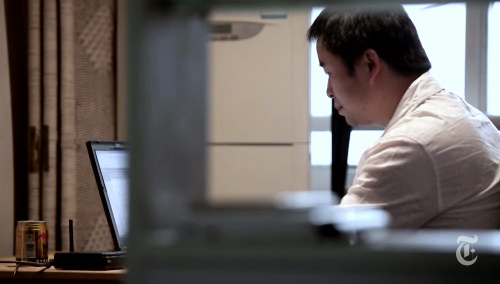
- A medium shot opens this sequence. We see the subject working at a computer. (Jonah Kessel/The New York Times)
-
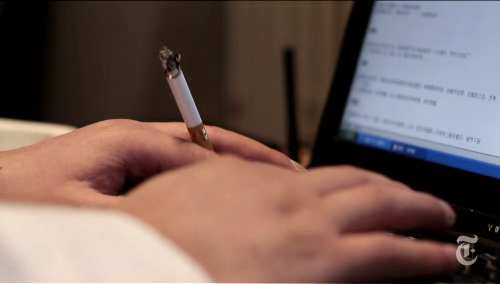
- The next shot is a close-up of the subject’s hands typing. Although the shot crosses the line of action, it provides good detail, and the absence of a second character minimizes any viewer disorientation. (Jonah Kessel/The New York Times)
-
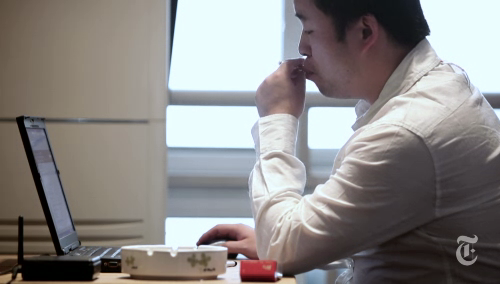
- Another medium shot is next in the sequence. This medium shot has slightly tighter framing, and the close-up second shot prevents what would be an awkward transition (and jump cut) between shots one and three. (Jonah Kessel/The New York Times)
Use different starting shots to create different effects. Start with a wide shot to establish location and a sense of place. Start with a close-up to provide a specific detail, while leaving some questions in viewers’ minds about exactly what’s happening. These questions can create anticipation and build momentum for your story. To better anticipate action, keep asking yourself two questions: What’s happening now and what’s going to happen next?
Finally, look for repeating actions. It’s easier to build a shot sequence around something that repeats or a process that takes some time to complete. Always keep an eye out for these opportunities on location.
Correction: An earlier version of this story incorrectly stated that the second shot featured in the New York Times video doesn’t cross the line of action.

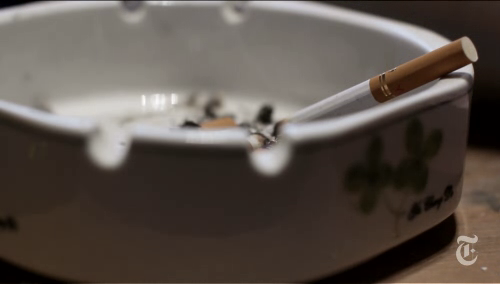





Comments